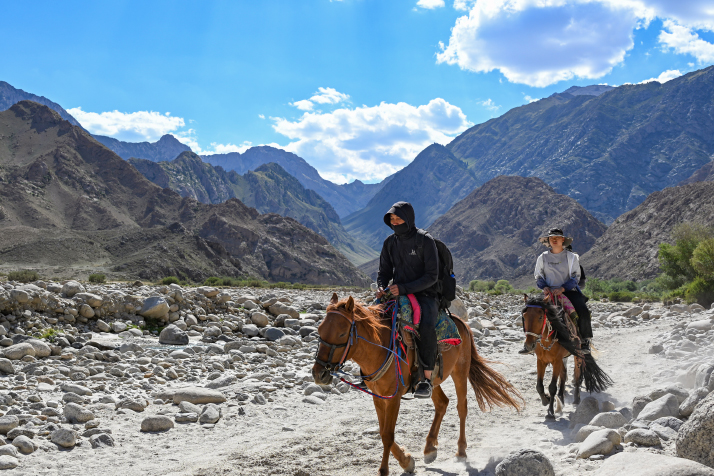| China |
| The tourism boom in the largest provincial-level region in China | |
|
|
 Tourists enjoy a camel ride in Turpan, Xinjiang Uygur Autonomous Region on June 29 (XINHUA)
Peak season for Xia Wei's inn, located in a small town within the vast Xinjiang Uygur Autonomous Region, always comes with the annual reopening of the Duku Highway.
This 560-km stretch of road, connecting Dushanzi in the north of Xinjiang to Kuqa City in the south, is a corridor of diverse natural landscapes, featuring canyons, grasslands, lakes and snow-capped mountains, offering travelers the extraordinary experience of encountering "four seasons in a single day and varying weather within 10 miles." The highway's high-altitude route necessitates a winter closure, making it inaccessible to travelers from October to June. This year, the highway welcomed travelers back on June 1, more than 10 days earlier than in previous years. With its reopening, the inns, restaurants and other businesses lined up along it have sprung back to life, ready to embrace the influx of adventurers drawn to this majestic landscape. A summer hotspot Xia manages the family inn sitting next to the Duku Highway with his parents. In earlier years, his father would venture out to the roadside to draw in customers. In May 2022, Xia made a pivotal move by registering his inn on e-commerce platform Meituan.com, which resulted in a considerable boost in bookings. That year, their revenue soared to 400,000 yuan ($55,000), tripling their 2019 income. This year, they are expecting even greater profits, thanks to a noticeable uptick in tourist flow along the highway. Since the start of July, the inn has boasted an impressive occupancy rate of over 90 percent. "The Duku Highway has become a newfound gem for tourists in Xinjiang," Li Fei, an experienced tour guide in the area, told Xinhua News Agency. "Previously, Xinjiang's visitors gravitated toward a few famous locations like Turpan and Kashgar. Today, less-explored destinations are winning over travelers keen to immerse themselves more fully into what Xinjiang has to offer. They prefer tailor-made travel plans and tend to prolong their stays in the region." Feng Xiujuan, a hiking enthusiast from Zhejiang Province, had long dreamed of trekking the Wusun Ancient Trail in Xinjiang. This trail, known for its blend of adventure, archaeology, hunting and rock climbing, and set against the backdrop of the majestic Tianshan Mountains, offers hikers stunning alpine views, including serene lakes, expansive grasslands and snow-capped peaks. The prime hiking season extends from June to September and Feng embarked on her journey during this window. "It was quite a spontaneous decision, but I'm eagerly anticipating the scenic beauty along the way," she told China News Service on June 9. "With the trail's services continually improving, I'm excited for this seven-day hike." Feng has noticed Xinjiang's increasing popularity among tourists. "Many friends are planning trips to Xinjiang this year," she said. "Even those who've visited before are keen to return, drawn by its vast landscapes, stunning views and rich ethnic cultures."  Trekkers embark on the Wusun Ancient Trail in Baicheng County, Xinjiang Uygur Autonomous Region on June 9 (XINHUA)
Managing the tourist surge The largest provincial-level region in China, Xinjiang covers 1.66 million square km, making up about one sixth of the country's total area. It features a diverse range of climates, landscapes including mountains and deserts, lakes and a rich tapestry of ethnic cultures. This year, tourism season in Xinjiang kicked off earlier than usual, sparked by the popular eight-part mini-series To the Wonder. Released in May and set in Altay in northern Xinjiang, the series has captivated domestic audiences and attracted a substantial number of visitors to Xinjiang. Traditionally, Altay's peak season begins in late June. This year, by early June, Altay had already welcomed 2.67 million visitors, an 80-percent increase year on year, generating tourism revenue of 2.2 billion yuan ($303 million), a 93-percent surge from the previous year, according to the local culture and tourism department. The commencement of the Eid al-Adha festival on June 16, celebrated by Muslims, further boosted tourist numbers. On the festival's first day, the Hemu Scenic Area in Altay announced it had reached maximum capacity. With the influx of visitors, challenges such as traffic congestion on the Duku Highway and a shortage of tickets for certain attractions have become more pronounced. Accommodations, including hotels and guesthouses, have reported full occupancy. Data from the Civil Aviation Administration of China indicated an uptick in domestic flight bookings to Xinjiang, with a 27-percent increase compared with last year, as observed up to June 19. This surge in interest has led several airlines to increase their services to the region. "The average load factor on China Southern Airlines' Xinjiang routes has exceeded 80 percent since June's start," a spokesperson for China Southern Airlines told Time News. The thriving tourism market has also catalyzed growth in Xinjiang's hotel and homestay sector. Qichacha, a business data provider, reported a swift rise in the registration of hotel-related businesses in Xinjiang, with 5,960 new entities established last year. By June 20, hotel bookings on travel platform Qunar this year had doubled compared with the same period of last year, highlighting the popularity of destinations like Ili, Urumqi, Altay and Kashgar. Domestic chains and international groups, including Hilton, have escalated their investments in Xinjiang, recognizing its untapped potential. "Xinjiang holds rich tourism resources, yet the market's current offerings fall short of meeting escalating tourist demand, creating substantial opportunities for development," Chen Mengchao, Vice President of Wanda Hotels & Resorts, explained to Time News, noting the company's accelerated hotel signings in the region since 2023. Chen also observed the lack of competition within Xinjiang's hotel market, especially in less-explored tourist spots. "However, given the ongoing increase in investment and tourism's rising popularity, we anticipate this dynamic may shift in the coming years," he said. Copyedited by G.P. Wilson Comments to yuanyuan@cicgamericas.com |
|
||||||||||||||||||||||||||||||
|